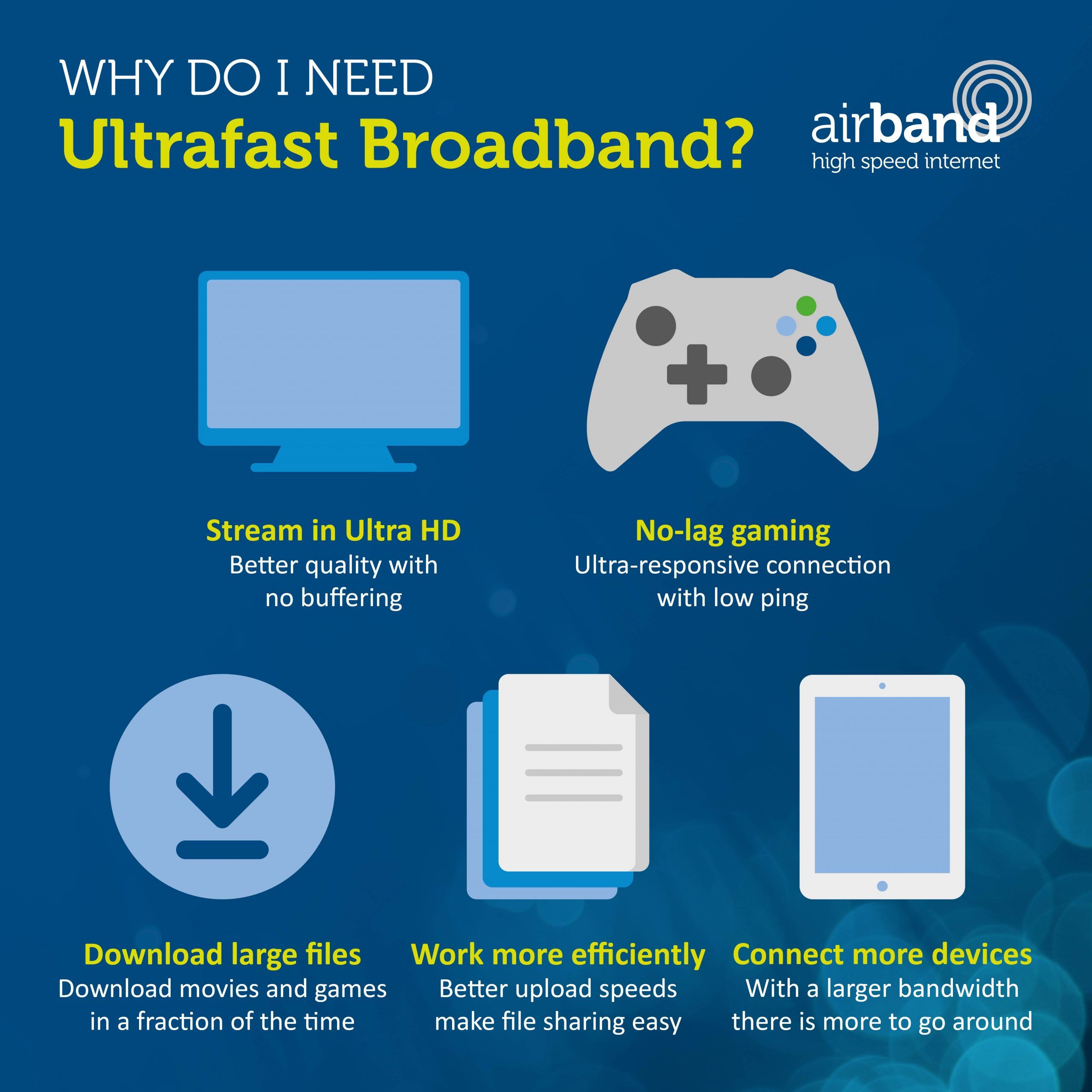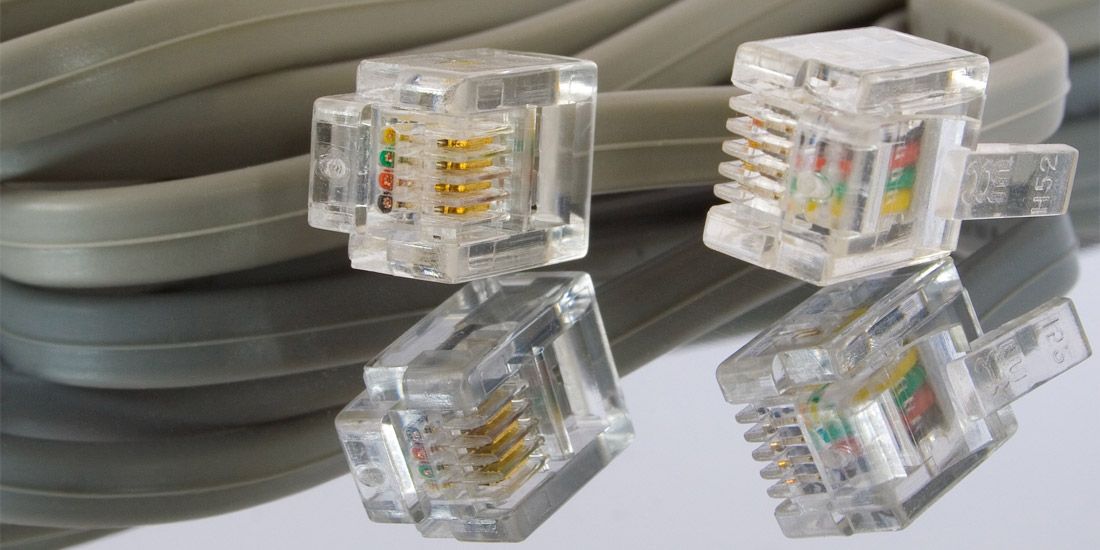Broadband or fibre? What’s the difference & which do you need?
19th August, 2022 | Home / Blog / Fibre broadband / Broadband or fibre? What’s the difference & which do you need?Reading time: 12 minutes

Broadband is a term we are all used to hearing about by now, and it can inspire feelings of dread and terror for some. But, it doesn’t have to be that way.
Choosing between fibre or ordinary copper broadband may seem like a complicated issue, but luckily, we’re here to make things simple. Want to know which is better, fibre optic or standard broadband?
We’ll break down the differences and help you decide whether your current broadband will be enough to keep you streaming, gaming, browsing and working seamlessly until your heart’s content.
Update May 2023
The copper switch off is going to happen in 2025. That means saying goodbye to copper landline technology. Find out if you’ll be affected.
Broadband vs Fibre Optic cables

The difference between traditional broadband and fibre is mainly down to speed. A fibre connection has the potential to be much faster and has a bigger bandwidth than other broadband options.
Is a fibre connection better than a traditional broadband connection?
Fibre broadband is the best broadband technology currently available on the market to connect you to the internet. So yes, fibre is worlds apart from any other broadband connection you may currently have.

Bear in mind though that an important distinction to make is what type of fibre broadband package you have, as not all fibre broadband options are created equal.
Fibre-to-the-premises (FTTP) broadband, also known as full fibre, uses fibre optic cables all the way from the exchange and to your doorstep and simply put, it’s the best broadband option available when picking a fibre package.
Meanwhile, fibre-to-the-cabinet (FTTC) broadband is only a part-fibre connection, which uses older copper broadband/telephone lines to make up the other part of the connection. This makes it much slower than the other fibre options.
If you’d like to know more, take a look at our blog post, FTTC vs FTTP.
It’s worth keeping in mind, that any fibre package will always be better than a traditional ADSL broadband line, as even just having a part fibre connection is an improvement on what is already there.
Is my broadband ADSL or fibre optic cable?
There is an easy way to work out if you have ADSL or fibre optic cable. If your broadband comes from the same line as your telephone cable, it uses copper in some part and is likely to be ADSL broadband (Asymmetric digital subscriber line).

For years, this was the only type of broadband available for most people. Of course, it was a step up from dial-up broadband, however as life has moved on and more of our lives are taking place online, the demand for speeds and bandwidth has gone through the roof.
Nowadays, most people need more than just ADSL broadband to get what they need from their internet connection. The good news is that part-fibre broadband is now available to most people up and down the UK.
Even though this is a big improvement, it still isn’t enough for many people, and a full-fibre connection is the only way to meet the ever-growing needs of most households.
If you live in the UK, you’re more than likely on a part-fibre part-copper connection, known as fibre-to-the-cabinet. Fibre brings the internet from the exchange to the nearest cabinet to you, and then copper phone lines feed the signal to your home. You can get speeds of up to 80Mbps with part fibre, which is pretty good, but only if you’re closer to the cabinet. Most people will only get less than half this speed on FTTC.
FTTP (fibre-to-the-premises) however can deliver speeds up to 1Gbps and is a full fibre line all the way to your home. If your connection isn’t delivered through a phone line and is fibre, it will be FTTP.
Want to know more? Here are some resources:
What are the 5 key differences between broadband and fibre?
- Speed
- Reliability
- Bandwidth
- Security
- Price
When deciding whether you want ADSL broadband or fibre, it’s important to consider the main things that are important to you, and what you might need to use your internet connection for.
How to decide if ADSL broadband or fibre broadband is right for you
1. Think about what speed you need
Different types of internet activity require different speeds. For example, if you only need to send the odd email, browse the internet on your mobile, or send a few WhatsApp messages, you’re not going to need a lot of download speed.
However, if you do a lot of streaming, gaming or video calling, you’ll definitely want to have a speedier connection for a better online experience.
If speed doesn’t really matter to you, and you only need the bare minimum, you might get enough with a standard broadband connection, however, if you need more than just a few Mbps, you’ll want to opt for fibre broadband.
2. Consider how reliable you need it
Some people need a reliable internet connection at all times of the day. This is especially true if you are trying to work or run a business online.
Imagine, you’re in an important video call with a potential customer and your connection suddenly drops out – that’s the last thing you want.
Fibre is more reliable than other broadband types, as each connection has its own dedicated line, and there is no fluctuation in speeds or service. Win-win!
3. Decide the bandwidth you need
Bandwidth is different to speed, as it talks about how much room you have on your connection at once. If you have lots of people using the internet at once, you are definitely going to need bigger bandwidth, whereas if there is just one sole user, bandwidth isn’t so much of an issue (that’s unless you need to use lots of devices at once, of course!).
Fibre broadband has a bigger bandwidth than traditional broadband. It is also an uncontended connection, which means that your broadband line is yours and yours alone, so you’re not sharing with anyone else on the network.
Traditional ADSL broadband is normally contended, which means that a lot of the time you are sharing your line with your neighbours, and if you’re all online at once, you may run into issues such as slower speeds and drops in signal.
4. Decide if security is important to you
If privacy and security are important to you, you’ll want to go with the connection which is more difficult to compromise.
In this case, a fibre connection will be safer and more secure, as you have your own dedicated line. This is especially true when it comes to running a business when keeping information confidential is extremely important.
5. Set a budget
For some people, keeping costs low is more important than anything else, especially when you have a tight budget to stick to.
If you’re a single person trying to keep your costs down as you don’t have anyone to spread bill costs with, you’ll want to go for the cheapest option and sacrifice the speed and quality of service in return.
Normally, fibre is more expensive than other broadband options, but this is because of the higher cost of building a fibre network. With traditional broadband, most of the time all of the infrastructure is already there, so it’s just a case of connecting you up or switching your provider.
Whereas, a fibre network needs to be built from scratch as its a new type of cable that needs to go in the ground.
Building the network costs the provider a lot of money, so understandably the upfront costs of fibre will be more, but the more people that join the network can make it more affordable, and month-on-month costs can still be quite competitive.
Is it worth having fibre optic broadband?
Yes it is worth having fibre optic broadband, especially if being able to stream, game, work, and communicate without hassle important to you.
Fibre broadband will definitely pay off and give you a more reliable connection than a standard broadband connection, plus, it’s built for the future too, so that means there’ll be no more switching to increase your speeds.

Most of us need a high-speed internet connection
Most people rely on their home broadband and it is now seen as a utility rather than a luxury. More people are working from home than ever and need a 24-hour reliable, ultrafast broadband connection in order to keep their lives up and running.
The main downsides to fibre broadband are that it may have a slightly higher upfront or monthly cost than traditional ADSL broadband, and it may take you longer to get installed (especially if it’s a brand new network).
In many cases, you should still be able to find an affordable fibre option, even as cheap as £20/per month.
So, the real question is, is choosing a slower, less reliable broadband option worth saving an extra few pounds each month? For most, the answer is no.
Have a look at our competitive fibre broadband packages here:
Should you choose 5G or fibre broadband?
If you’ve got the choice between 5G or fibre broadband and are wondering which one to choose, ask yourself how much data you’re likely to use.
If you only need the internet intermittently throughout the day and only use it for lighter activities (such as checking emails or listening to music) that won’t use much data, 5G could be a good option as it is fast, and you can select a data package to suit your needs.
However, if you want to do plenty of activities online such as streaming Netflix or gaming, you’ll want to have a fast, fibre connection. This is because even though 5G sim contracts may be a smaller cost per month at first, if you end up going through all your data, buying more can become very expensive.
Another thing to take note of is what the signal is like in your area. Can you actually get a 5G signal in all areas of your home? And is the signal strong and secure enough for everyone?

One thing is sure, a fibre broadband connection is definitely going to be a more reliable option, as it is a fixed-line service. 5G relies on wireless signals which can be affected b a number of factors such as weather conditions, and you’ll experience far more fluctuations in speed and quality of service.
Don’t know whether to choose 5G or fibre broadband? The short answer is this:
- If you’re looking for something quick, easy to set up, flexible and cheap, consider 5G.
- If you’re looking for faster speeds, unlimited data and greater reliability, choose a fibre broadband connection.
Broadband vs WiFi vs fibre
Broadband
It’s the way the internet is delivered to your home.
Worldwide, most broadband connections use a technology called ADSL, however broadband is a general term for internet connection, so it can mean fibre, 4G, wireless, satellite and more.
WiFi
It’s actually the internet network inside your home, or whatever place you’re in. WiFi is a mini network which broadcasts the internet signal from your router for your devices to connect to wirelessly.
Fun fact – WiFi doesn’t actually stand for anything – it’s actually just the brand name for it. Some people like to think it’s a play on words that relate to Hi-Fi sound systems.
Fibre
Fibre is an amazing technology that has transformed broadband forever. It is a special type of cable made from fibreglass that allows signals to be sent using the power of light, at the speed of light! Impressive, right? Fibre can transmit data much, much faster than you think.
So if you’ve been thinking the two types of broadband get you roughly the same speed, you’d be wrong.
It can achieve speeds much higher than older types of broadband like ADSL, which uses copper cables and is much slower. A lot of people are on a fibre connection, however only a part fibre one. Our mission is to get unlimited fibre to everyone.
What is the difference between fibre and standard broadband?
The difference between fibre and standard broadband is fibre is faster, but might not be available to everyone yet. Standard broadband is more widely available, but isn’t as reliable or fast.
Fibre broadband
- Pros: Ultrafast, reliable, bigger bandwidth, future proof
- Cons: Longer install times, sometimes more expensive, not available to everyone
Standard broadband
- Pros: Most people can get it, fast enough to do basic tasks, often cheaper than other options, quick to get connected
- Cons: Small bandwidth, less reliable, slower, not always cheaper.
For most people, fibre broadband is probably going to be the right choice, however, it may not be available yet.
What about the average speeds of broadband and fibre internet?
Fibre optic will typically get you faster download speeds on multiple devices. It’s much faster than the original broadband’s actual speed.
So, no more struggling for internet service or pulling your hair out because you can’t download large files at peak times when you need that high-speed data.
Find out more about the fastest internet speeds in the world.
What is fibre internet?
Fibre internet is also known as fibre broadband, or FTTP. It uses fibre optic cables to transmit data signals at the speed of light, almost. It’s much faster than ADSL or wireless broadband.
What is fibre optic broadband?
Fibre optic broadband is another way of saying fibre broadband, fibre optic, or FTTP. It refers to the fibre technology.
Do I need fibre optic broadband?
Yes, you need fibre optic broadband if you want a faster, more reliable connection than wireless broadband. Fibre optic broadband can get speeds up to 900Mbps.
Can I get fibre broadband?
If you’d like to find out if you can get faster broadband yourself, head over to our broadband coverage checker. Enter your postcode to see if you’re in range. Our broadband packages range from 150Mbps, all the way up to 900Mbps.
With all our broadband packages, we’ll provide a free survey and free installation too.
Related Articles
Check availability:


